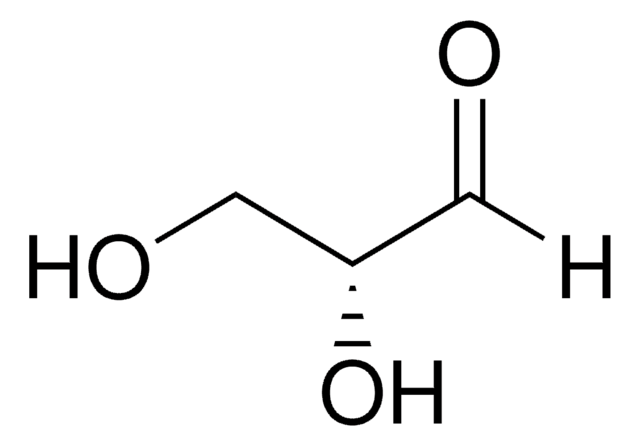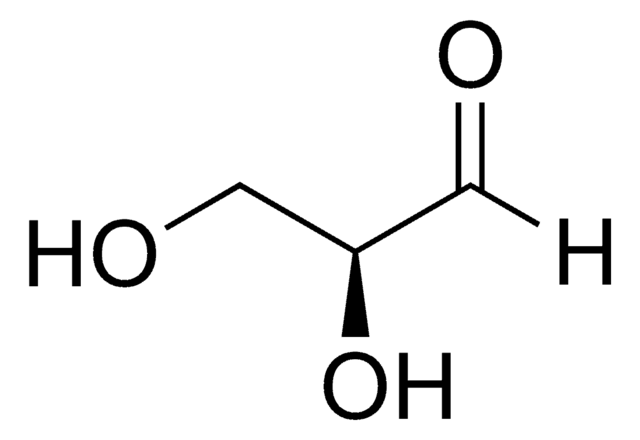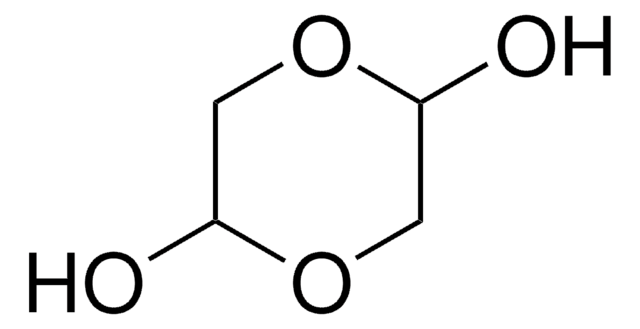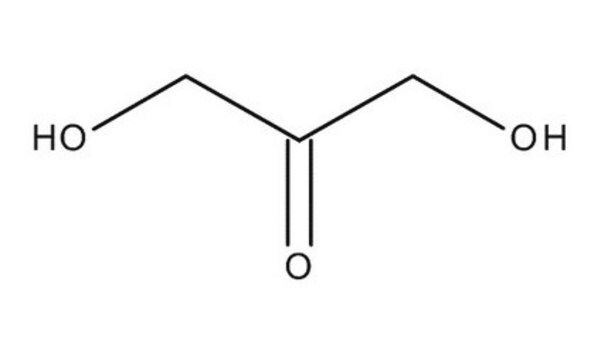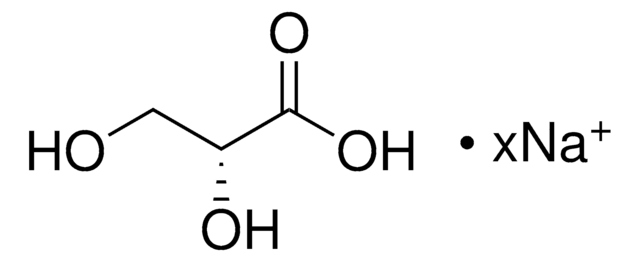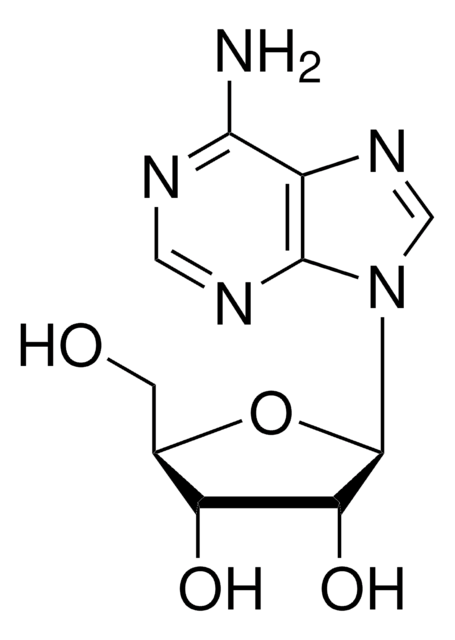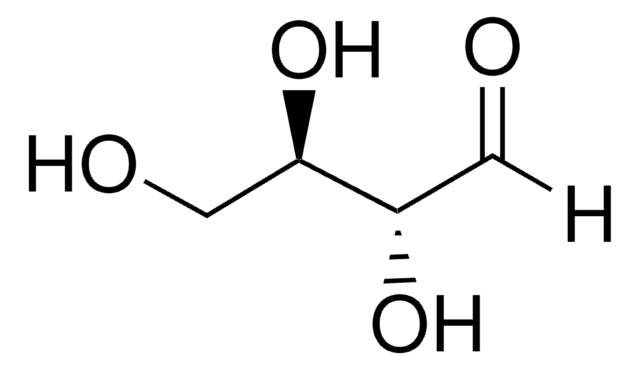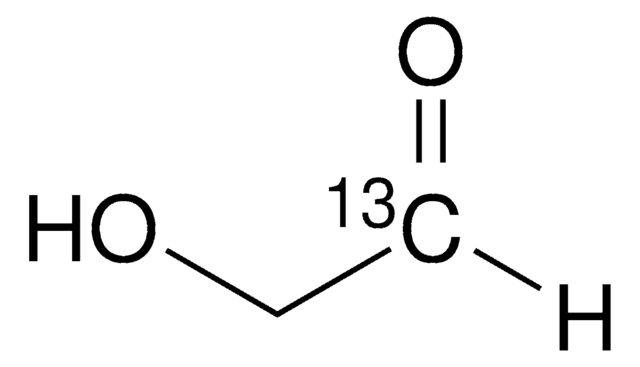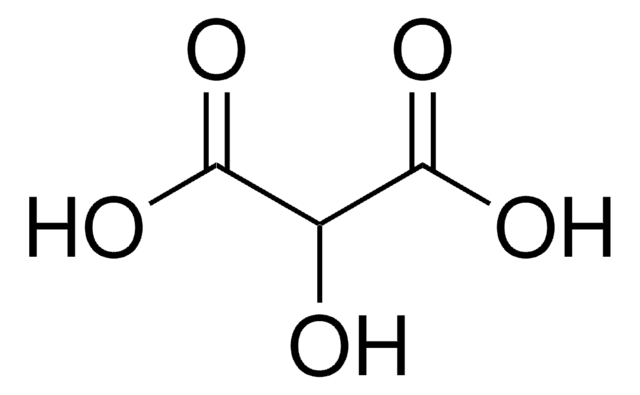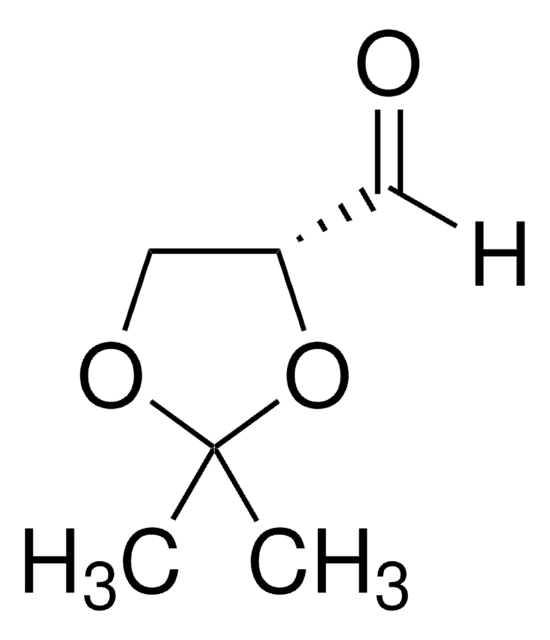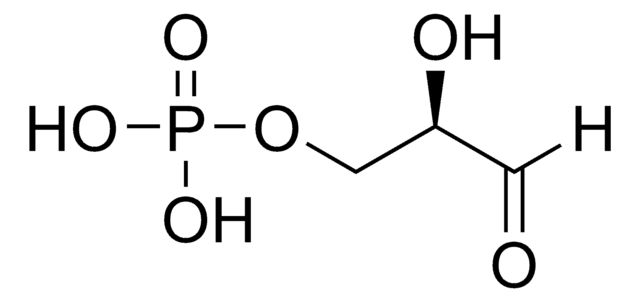G5001
DL-Glyceraldehyde
≥90% (GC)
Sinonimo/i:
α,β-Dihydroxypropionaldehyde, 2,3-Dihydroxypropanal
Autenticatiper visualizzare i prezzi riservati alla tua organizzazione & contrattuali
About This Item
Formula empirica (notazione di Hill):
C3H6O3
Numero CAS:
Peso molecolare:
90.08
Numero CE:
Numero MDL:
Codice UNSPSC:
12352201
ID PubChem:
NACRES:
NA.25
Prodotti consigliati
Origine biologica
synthetic
Livello qualitativo
Saggio
≥90% (GC)
Stato
powder
Colore
white to off-white
Punto di fusione
145 °C ((293 °F ))
Solubilità
water: 50 mg/mL, clear to slightly hazy, colorless to faintly yellow
Temperatura di conservazione
room temp
Stringa SMILE
[H]C(=O)C(O)CO
InChI
1S/C3H6O3/c4-1-3(6)2-5/h1,3,5-6H,2H2
MNQZXJOMYWMBOU-UHFFFAOYSA-N
Descrizione generale
Glyceraldehyde is a simple monosaccharide. Based on the number of carbon atoms and the type of carbonyl group present, glyceraldehyde belongs to subgroup triose. It is a colourless and sweet compound.
Applicazioni
DL-Glyceraldehyde has been used:
- as modifying reagent in the preparation of crystallization solution
- as a substrate to measure aldose reductase activity
- in the preparation of d/l-glyceraldehyde stock to determine the specific activity of GAPDH (glyceraldehyde 3-phosphate dehydrogenase)
Azioni biochim/fisiol
Glyceraldehyde serves as an efficient cross-linking agent and is considered non-toxic. It is an intermediate of a number of metabolic such as glycolysis and pentose phosphate pathway.
Altre note
DL-Glyceraldehyde is a substrate for the enzyme aldose reductase.
To gain a comprehensive understanding of our extensive range of Monosaccharides for your research, we encourage you to visit our Carbohydrates Category page.
Codice della classe di stoccaggio
11 - Combustible Solids
Classe di pericolosità dell'acqua (WGK)
WGK 3
Punto d’infiammabilità (°F)
Not applicable
Punto d’infiammabilità (°C)
Not applicable
Dispositivi di protezione individuale
Eyeshields, Gloves, type N95 (US)
Scegli una delle versioni più recenti:
Possiedi già questo prodotto?
I documenti relativi ai prodotti acquistati recentemente sono disponibili nell’Archivio dei documenti.
I clienti hanno visto anche
Gemma Sangüesa et al.
European journal of nutrition, 58(3), 1283-1297 (2018-03-09)
Sugar-sweetened beverage intake is a risk factor for insulin resistance, dyslipidemia, fatty liver, and steatohepatitis (NASH). Sub-chronic supplementation of liquid fructose, but not glucose, in female rats increases liver and plasma triglycerides without inflammation. We hypothesized that chronic supplementation of
Raman and infrared spectroscopy of carbohydrates: a review
Wiercigroch E, et al.
Spectrochimica Acta. Part A, Molecular and Biomolecular Spectroscopy, 185(5), 317-335 (2017)
Chethan Sampath et al.
Biomedicine & pharmacotherapy = Biomedecine & pharmacotherapie, 84, 502-513 (2016-09-30)
Hyperglycemic stress activates polyol pathway and aldose reductase (AR) key enzyme responsible for generating secondary complications during diabetes. In this study the therapeutic potential of phloretin, epigallocatechin 3-gallate (EGCG) and [6]-gingerol were evaluated for anti-glycating and AR inhibitory activity in
GAPDH and Intermediary Metabolism
GAPDH: Biological Properties and Diversity, 37-59 (2012)
Stabilization of scleral collagen by glycerol aldehyde cross-linking
N.A.Danilov, et al.
Biochimica et Biophysica Acta, 1780(5), 764-772 (2008)
Il team dei nostri ricercatori vanta grande esperienza in tutte le aree della ricerca quali Life Science, scienza dei materiali, sintesi chimica, cromatografia, discipline analitiche, ecc..
Contatta l'Assistenza Tecnica.